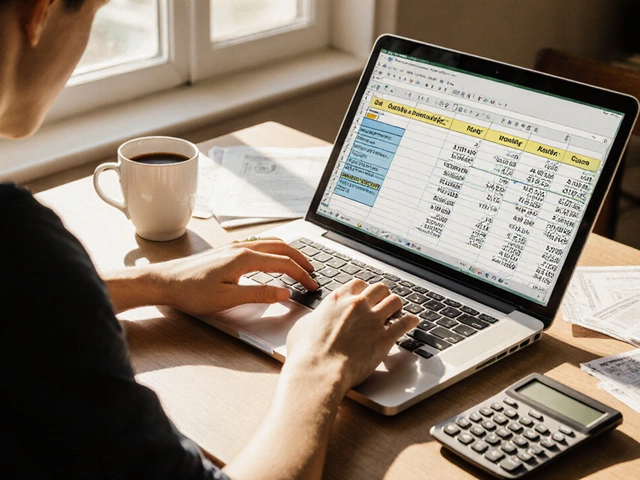Average Profit on Commercial Real Estate: What Investors Really Make

If you think commercial real estate is an easy ticket to wealth, you're in for a surprise. Sure, plenty of folks have made good money flipping offices or renting out storefronts, but the average profit isn't as wild as the headlines. Investors want to know: after all the costs and headaches, what's left in your pocket?
First, let's clear up what 'profit' actually means here. It isn’t just rent checks minus your mortgage. You have to factor in maintenance, vacancies, property taxes, management fees, and those annoying surprise repairs. Trust me, nothing burns through your rental profits like a busted HVAC system in the middle of July—Shadow, my dog, could tell you a story or two about sweating through that one last summer.
So, if you want real profit numbers, you need to look past gross rent. What matters is your net operating income, minus all expenses, then compare it to what you originally paid. That’s how you find your true average profit, and it’s the difference between a dream deal and a money pit.
- Crunching the Numbers: What Is 'Average Profit'?
- Key Factors That Change the Math
- Real-World Profit Ranges You Can Expect
- Hidden Costs and How to Avoid Surprises
- Tips to Max Out Your Commercial Property Returns
Crunching the Numbers: What Is 'Average Profit'?
When people talk about the average profit on commercial real estate, most folks imagine a simple number—buy low, sell high, rake in the cash. In real life, figuring out your actual profit is more like piecing together a messy jigsaw puzzle. You can’t just look at your rental income and call it a day.
Here’s how serious investors break it down: you start with your gross rental income, then subtract all costs—not just the mortgage, but also property taxes, insurance, maintenance, management fees, and those occasional “whoops” repairs that every property seems to have. The result is called your Net Operating Income (NOI).
Once you have your NOI, many buyers look at their investment returns by comparing it to what they paid for the property. This is called the capitalization rate, or cap rate. For example, if your building brings in $100,000 in NOI each year and you bought it for $1,250,000, your cap rate is 8%. Simple formula:
- Cap Rate = Net Operating Income / Purchase Price
But there’s more to profit than just the income. If you sell the building and the value’s gone up, you’re also pocketing the appreciation. According to CBRE’s 2024 report, average annual returns on U.S. commercial real estate (combining rental income and price gains) landed between 7% and 10% per year over the past decade. That’s before you pay taxes and fees—and before any market surprises.
| Component | Description | Example (USD) |
|---|---|---|
| Gross Rental Income | Total collected from tenants | $200,000 |
| Operating Expenses | Maintenance, taxes, management | $80,000 |
| Net Operating Income (NOI) | Income minus operating expenses | $120,000 |
| Purchase Price | What you paid | $1,500,000 |
| Cap Rate | NOI divided by Price | 8% |
One more thing—don’t forget leverage. If you took out a loan, your return on cash invested (cash-on-cash return) could actually be much higher, but your risks are higher too. Bottom line: you have to look at income, expenses, property value changes, and financing. It's not magic, just smart, honest math.
Key Factors That Change the Math
Here’s where it gets real: so much goes into that final profit number on commercial real estate, and it’s never as simple as just buying low and selling high. These main things will mess with your bottom line, sometimes in ways you don’t see coming.
- Location: Not all properties are created equal. A retail space in a busy city spot can rake in way more than a similar spot in a ghost-town strip mall. Location influences rent prices, how fast you fill vacancies, and how much the property is worth when you cash out.
- Property Type: Office buildings, warehouses, apartment complexes, and retail shops all have different typical average profit margins. For example, self-storage buildings might have lower risky tenants but steadier profits, while restaurants bring higher risk (they close more often) and higher potential reward.
- Market Cycles: The value of commercial real estate goes up and down like everything else. During an economic boom, property values and rents climb. But when things slow down, vacancy goes up and profits shrink. COVID-19 hammered offices, but warehouses actually took off because of skyrocketing e-commerce.
- Leases and Tenants: Long-term leases with solid companies mean steady income, less headache, and less risk. If you’re stuck with short-term leases or if your property attracts higher-turnover tenants, you’ll spend more time (and money) chasing new renters and fixing up the space.
- Operating Costs: Insurance, property taxes, management fees, repairs—these kill profits if you don’t plan. Insurance in Florida? Prepare yourself. Some parts of the country have tax deals or energy incentives that make a huge difference.
- Financing Terms: The interest rate on your loan can flip your returns. If you locked in at 3.5% a few years ago, you’re probably laughing right now. Anybody buying commercial property in 2024-2025 is working with rates closer to 7% or higher, which chops right into your profit.
Here’s an example of how these factors play out. Check this quick snapshot comparing different types of commercial real estate and their usual investment returns:
| Property Type | Typical Cap Rate (2024) |
|---|---|
| Industrial/Warehouse | 6%-8% |
| Retail | 5%-7% |
| Office | 6%-7% |
| Multifamily | 4%-6% |
| Self-Storage | 5%-8% |
This is why it’s so important to break down every number before you buy. Sometimes, a property that looks cheap comes with higher vacancy or crazy taxes, wiping out that sweet profit you pictured. On the flip side, a pricier spot in a growing area could mean bigger steady gains. Always run the math and don’t trust your gut alone—unless your gut’s got a calculator built in!

Real-World Profit Ranges You Can Expect
Here’s the part you actually came for: how much does the average investor make from commercial real estate? Nobody likes vague answers, so let’s break down what you can really expect before taxes and after all those nasty expenses.
On the whole, commercial properties typically see annual returns between 6% and 12% of the property’s value. This means if you own a building worth $1 million, you might pocket $60,000 to $120,000 a year once operating expenses are paid. Of course, the type of property matters a ton. Office spaces, retail, and warehouses each play by their own rules. According to data from the National Association of Realtors in 2024, here’s a general snapshot of average profit margins:
| Property Type | Average Annual Return |
|---|---|
| Office | 7% - 10% |
| Retail | 6% - 8% |
| Industrial/Warehouse | 8% - 12% |
| Multifamily (Apartment) | 5% - 9% |
If you’re in a hot market (think downtown areas in big cities), you’ll probably see numbers at the higher end. Meanwhile, smaller towns often bring more risk and lower returns. There’s less demand, so empty storefronts or units can eat your average profit right up. Even so, certain investors do manage to score above-average returns—sometimes 15% or more—by snapping up undervalued properties and working some magic with upgrades and smart leasing.
Just remember, those home-run deals usually come with more work and more risk. If you want steady and safer, the mid-single digits are common. Most investors who succeed in commercial property sale are happy if their returns land above 8% after all expenses are paid. Anything much lower, and you’re probably better off parking your money elsewhere.
Hidden Costs and How to Avoid Surprises
It’s easy to look at a commercial real estate deal and think the biggest costs are just the loan and maybe a fresh coat of paint. Everyone does it. But the real budget-busters creep up after you close—and they rarely announce themselves.
Start with repairs. An old roof might look fine until the rainy season shows up (thanks for the surprise leak last spring, Mia). Then you’re writing a check for $30,000 when you least expect it. Elevator inspections, sprinkler systems, and HVAC repairs also tend to drain accounts. Typical annual maintenance can eat up 1-4% of your property value every year, and nobody warns you in bold print.
Next come property taxes. These jump up when tax assessors re-evaluate properties—especially after a sale. Don’t assume the last bill is what you’ll pay going forward. A spike of 30% isn’t unheard of, especially in hot markets. It’s also smart to budget for insurance hikes. After natural disasters or even a few claims, commercial property insurance can shoot up, catching even experienced investors off guard.
If you use a property manager, expect management fees around 4-10% of your gross rent. These aren’t optional if you want trouble-free tenants but they’ll shrink your average profit. Let’s not forget legal and compliance costs, either. Just this year, new fire safety rules led to mandatory upgrades for several local strip malls. Nobody loves paying a lawyer or hiring inspectors, but it's better than getting fined or sued.
Surprised yet? That’s the point. Successful owners tackle this stuff head-on with a real budget. Do a detailed cash flow projection before signing anything. Even seasoned pros often keep a reserve fund—some aim for at least three months of operating expenses set aside for mini disasters.
- Inspect everything: Don’t trust seller talk. Pay for thorough building and systems checks.
- Read the fine print: Review lease terms—triple net (NNN) leases push repairs and taxes to tenants, saving you headaches.
- Plan for turnover: Vacancies happen, so estimate at least 5-10% of lost rent per year.
- Compare insurance options: Shop around and get specialist advice. This is not where you want to cheap out.
- Set up a reserve fund: Cover at least three months of expenses to sleep a little better at night.
| Cost Type | Low Estimate | High Estimate |
|---|---|---|
| Repairs/Maintenance | 1% | 4% |
| Property Management | 4% | 10% |
| Insurance | 0.5% | 2% |
| Property Taxes | 1% | 3% |
Every extra dollar you plan for upfront saves you a ton of stress (and money) later. That’s how you keep your investment returns strong—and your blood pressure low.

Tips to Max Out Your Commercial Property Returns
If you want to squeeze every extra dollar of profit from your commercial real estate, you need to be smart, hands-on, and not afraid to question every cost. Investors who just sit back and hope for the best are the ones who wonder why their bank account isn’t growing.
Start with your leases—they’re the backbone of your returns. Don’t just use whatever the last owner had; set competitive rates, lock-in annual increases, and always check tenant credit. According to a 2024 National Association of Realtors report, properties with annual rent escalations of 2-3% outperform those with flat leases by as much as 15% over five years.
Next up: tackle costs. Utility bills, property management, insurance—every dollar you cut is a dollar of pure profit. If you haven’t gotten your building re-evaluated for energy efficiency, you’re leaving money on the table. Swapping out old lights for LEDs or tweaking the HVAC can make a real dent in your monthly expenses.
It’s also key to keep your spaces full. Empty units eat away at your potential average profit. Offer move-in deals, flexible floor plans, or even short-term leases if it means less downtime between tenants. Vacancy costs are the fastest way to watch returns shrink.
And don’t skip regular property checkups—it’s way cheaper to fix a small roof leak now than replace moldy drywall six months later. Proactive maintenance keeps the big repair bills at bay and keeps tenants happy, which means fewer unexpected move-outs.
Cap rates matter too. Every city has its own average, but always compare your building’s actual net income to what’s typical nearby. If your property is under-performing, find out why and fix it. According to CBRE’s 2024 market outlook, the national average cap rate for office properties is 6.7%, but well-run, upgraded buildings in growth markets can do even better.
| Strategy | Potential Impact on Returns |
|---|---|
| Annual rent increases (2-3%) | Up to 15% higher profit over 5 years |
| Energy-efficient upgrades | Cut 10-25% from operating expenses |
| High occupancy rates (>90%) | Boosts yearly net income by thousands |
One last tip: always have a plan for exit—even if you aren’t selling now. “Good real estate investing is about having more than one way to win,” says Brian Bailey, CRE market specialist at the Federal Reserve.
“Your property’s value depends as much on your next move as today’s rent checks. An exit plan protects your bottom line.”
Get the basics right, keep learning, and watch your commercial real estate profits grow—not just year to year, but for the long haul.









Write a comment